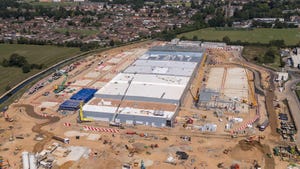Linear Programming Helps Groupon Optimize Data Center Design
Shopping discount giant translates mathematical model used in other industries to data centers


Design-theme-art
This month, we focus on data center design. We’ll look into design best practices, examine in depth some of the most interesting recent design trends, explore new ideas, and talk with leading data center design experts.
Groupon may be the future of merchant discounts, but it uses a mathematical problem solving method formulated in the 1930s to optimize the data center design that supports its popular service.
Linear Programming models are used to maximize specific outcomes given numerous variables. The word “linear” refers to linear relationships between the variables.
The approach is common in other industries, such as transportation, energy, and telecommunications, but it also applies well in data center design, the Groupon team found, since there are clearly desirable outcomes and lots of variables.
The goal was to maximize space and power utilization at the rack level and optimize “striping,” which is distributing servers that perform similar functions across multiple racks to improve reliability, Harmail Chatha, Groupon’s director of global data center operations, said.
At the end of 2015, Groupon launched a new data center in Sacramento, California, leasing wholesale space in the new building the massive RagingWire data center campus there. This was the first site where Groupon used the approach.
Read more: RagingWire Takes Its Massive-Scale, Luxury-Amenities Data Center Model to Texas
Chatha’s team studied the IT environment over the course of several months, trying to understand power utilization levels by various types of servers that support its service and generate variables for the model, including day, time, and seasonality. “The output [of the model] was how many servers we should deploy per rack,” he said.
The approach replaces intuition and prior knowledge, which is what data center operators usually rely on when making such decisions, Chatha said.
From Cloud to Wholesale Data Center Leases
Groupon started in 2008 and for its first several years relied on public cloud services for its infrastructure. Around 2011 the company’s user base reached a size where it made more sense to switch to an on-premise data center model.
Today, it operates primarily out of its own data centers leased from wholesale data center providers on both coasts of the US, as well as in Europe and Asia. Chatha declined to specify how many data centers the company had or where. The company also has retail colocation footprint, which comes into the fold as it acquires other firms, but that footprint usually gets consolidated into the wholesale facilities over time.
Read more: Need for Speed: How Groupon Migrated to Node.js
Keeping up with growth is always a moving target for its data center team. At the time of Groupon’s IPO in 2011 – which was then billed as the biggest IPO by a web company since Google – Groupon had fewer than 1,000 deals available, Nicholas Halliwell, the company’s spokesman, said. At the end of the third quarter of 2015, the company was advertising 550,000 active deals globally, with about 290,000 of them in North America.
Much of the capacity planning work Chatha and his team do revolves around supporting the next holiday season, he said. That’s when demand is highest. They also track new features and their impact on data center demand.
The Groupon deal is an example of RagingWire’s transition from a retail colocation model to a mix of retail and wholesale. It is marketing its new 14MW Sacramento facility, where Groupon took space, as a wholesale data center, as well as facilities it is building in Ashburn, Virginia, and the Dallas-Fort Worth market.
RagingWire president Doug Adams said the provider's move into the wholesale market was possible thanks to its parent company, Japan's NTT Communications, which acquired an 80-percent stake in 2013. "We have begun a strategic expansion into the wholesale data center market with the backing of our parent NTT Communications," he said in a statement.
Containment, While Infrastructure to Optimize Efficiency
At RagingWire, Groupon has leased a 5,000-square-foot data hall with 1 MW of power capacity, a lot of which is to prepare for future growth, Chatha said. The data center provider’s CA3 building was completed last year.
To optimize for energy efficiency, the Groupon team used containment pods, rather than curtains, and took extra measures to make sure there are no air leaks in its cold aisle containment system. “We’ve taken it to the next level,” Chatha said about the meticulous sealing exercise his team went through.
They also deliberately used all-white infrastructure in the environment, which also helps save energy, according to Chatha. “Everything within the environment is white,” he said. “There’s about a 3 percent savings on energy costs when you’re doing white-on-white infrastructure.”
White infrastructure means you need less lighting. It also helps with cooling. “Black color tends to hold heat, where white doesn’t,” he said.
While they may appear relatively small efficiency wins, they add up to substantial savings as web companies grow their data center infrastructure. Small energy savings across a row of racks can turn into millions of dollars in energy cost savings at scale.
This article has been updated with more information about RagingWire's move into the wholesale data center market.
About the Author
You May Also Like


.jpg?width=300&auto=webp&quality=80&disable=upscale)




